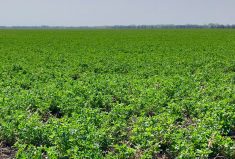Scientists studying the two major root rot problems for pulses in Western Canada have had small victories, but good chemical control is still a ways away.
“I think it is really important to emphasize that it’s a complex issue, and complex issues just take time,” said Sabine Banniza, a professor of plant pathology with the University of Saskatchewan.
Research into root rots such as aphanomyces and fusarium is like studying ways to beat cancer in humans, she said. It’s a big job.
Read Also

Fertilizer Canada-led campaign highlights environmental stewardship
Make Your Acres Count campaign aids Alberta farmers in getting recognized for their environmental stewardship in their crop production.
“Researchers have worked on (cancer) for decades and it’s not as if we are cancer-free by now. So some of these really complex diseases in plants also require a lot of time to get a handle on them.”
In the meantime, she said, researchers need producers to use all the best practices in their toolboxes — particularly effective rotations — to hold the soil-borne diseases at bay.
“They have to be more aware of rotational impacts on root rots if they have infected fields, and then act accordingly,” she said.
”I totally understand that there are always economic drivers in making decisions on what crop to grow, but maybe there should be a little bit of a question about short-term benefit versus long-term risk.”
One of the biggest breakthroughs of the last few years was the discovery that many species of fusarium are actually “complexes” of several fusarium species. Not surprisingly, complexes of more than one species can cause more damage than a single species.
“We knew that aphanomyces, fusarium avenaceum, fusarium solani and fusarium oxysporum are the main pathogens on our big (pulse) crops, pea and lentil,” said Banniza.
Of the fusarium species, Banniza and fellow researchers with the U of S’s Crop Development Centre are working on fusarium solani and fusarium oxysporum.
“We have established … that there are four separate species that were thrown together in the past and called Fusarium solani.”
Fusarium oxysporum is also a complex of various fusarium species.
This may not matter much from a crop management perspective, but it’s invaluable information for breeding resistance, she said.
“It’s very important for us to understand whether we are dealing with one species or whether we are dealing with four species. We now have to figure out whether all of these species equally infect all of the pulse crops or not,” said Banniza.
Several fusarium species — particularly fusarium avenaceum — are also known to infect wheat.
A group of scientists with Agriculture Canada in Lethbridge is isolating fusarium avenaceum from wheat and then inoculating those isolates onto peas and lentils to see if the same isolates that are virulent on wheat are also virulent on the pulses, said Banniza.
“It’s in the reverse as well. If you isolate fusarium avenaceum from pea in the field or from lentil in the field and then inoculate it onto wheat, (we can find out) whether they are virulent on wheat.
“That is really the important information for breeding and also for agronomy because that may influence rotations. If you have different populations on wheat and on pea and lentil, maybe then the rotation can still have some effect on at least not increasing F.avenaceum from pea and lentil where you’ve grown wheat.”
Another significant achievement has been the development of pea lines that have some partial resistance to aphanomyces, said Banniza. However, there is still a lot of work to be done.
“It’s only last year that we were able to do the first screening in the field. They do reduce root rot, but only a little bit because they are not resistant to the fusarium species.”
Unfortunately, Banniza and her U of S colleague Tom Warkentin found that the first generation of partially resistant peas they developed was relatively low-yielding, but that can be explained by the narrow focus of the research project, said Banniza.
“This was a research project focused solely on resistance and not yield or lodging or any of the other traits that you want to see in an elite pea variety. You can only do that in the context of the general breeding program. This was a research project very much focused on moving the resistance into the background of our varieties.”
Banniza said there will only be a dramatic reduction in root rot once researchers find a way to combine resistance to aphanomyces, fusarium avenaceum, fusarium solani and fusarium oxysporum.
“That’s what Tom Warkentin is doing now. He’s started to combine the aphanomyces root rot resistance with fusarium avenaceum resistance.”
Western Canadian researchers have been throwing everything they’ve got at the root rot diseases since aphanomyces euteiches was identified in Alberta and Saskatchewan in 2012.
In 2016 and 2017, an Agriculture Canada study in Lethbridge led by Syama Chatterton studied a what’s-what of chemical seed treatments on pea crops at Lethbridge and Taber, Alta. None of them were found effective.
Oddly enough, a Japanese fungicidal seed treatment called hymexazol, registered in the United States for use on sugar beets, turned out to be the only tested chemical to control some forms of root rot. However, it was deemed too expensive in the context of Western Canada’s pulse and wheat industries.
Other than that, the best contenders are possibilities that can control root rot when combined with something else. Rancona Trio — a seed treatment registered in Canada for early season suppression of aphanomyces in lentils, peas and fababeans — is one such example.
Chatterton tested the product (a combination of carbathiin, metalaxyl and ipconazole active ingredients) in 2021, 2022 and 2023 on fields in five locations — Lacombe and Taber in Alberta and Redvers, Scott and Swift Current in Saskatchewan.
She investigated Rancona Trio on its own and combined with partially aphanomyces-resistant pea germplasm from Europe.
Although the first two years of the study were too dry to host moisture-loving aphanomyces, the third year saw a significant reduction at four out of five sites. However, it only did so when combined with the European pea germplasm, a combination that appeared to go beyond suppression into control of root rot.
“So as we move towards releasing pea varieties with some partial resistance, maybe Rancona Trio will be an option to improve root rot problems,” said Banniza.
Michelle Hubbard, also a researcher with Agriculture Canada in Lethbridge, has tested several products and combinations of products — including lime, gypsum and MustGrow — throughout Alberta and Saskatchewan in recent years, only to find their suppression of root rot to be highly variable.
MustGrow is a mustard-based product that controls soil-borne pests and diseases in fruits and vegetables.
However, like Rancona Trio, these options might work when combined with partial resistance.
Banniza hopes a five-year strategic research initiative supported by the Saskatchewan government, Results Driven Agriculture Research in Alberta, the Western Grains Research Foundation and provincial pulse grower organizations will allow more opportunity to investigate these potential solutions.
The grower organizations include Saskatchewan Pulse Growers, Alberta Pulse Growers and Manitoba Pulse and Soybean Growers.
“Michelle will be looking at combining treatments like gypsum or lime or MustGrow, and then once we have more (pulse) lines with partial resistance, combining partial resistance with these treatments.”
Ultimately, Banniza doubts there will be a “single-tool solution” to aphanomyces and fusarium root rots, and whatever finally comes down the pipeline will probably take a little more work than a simple application.
“It will be a more complicated way of management that will involve resistance. It will involve, hopefully, some seed treatments or soil treatments. And so it will be more complex than just going out and liming or whatever and then that is the end of the story.”
Another major component of the initiative will be a long-term rotation study across several sites in Saskatchewan. Pulse farmers are being encouraged to engage in lengthy rotations in an effort to tackle the root rot diseases. This goal of the study is to gather data on the effects of six- to eight-year-long rotations.
“It’s to look at what exactly is happening over six years or eight years in these locations because we really don’t have any hard data from Saskatchewan on that,” said Banniza.
















